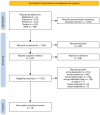The Role of Different Feedback Devices in the Survival of Patients in Cardiac Arrest: Systematic Review with Meta-Analysis
- PMID: 39408049
- PMCID: PMC11477487
- DOI: 10.3390/jcm13195989
The Role of Different Feedback Devices in the Survival of Patients in Cardiac Arrest: Systematic Review with Meta-Analysis
Abstract
Background: Cardiac arrest is a critical condition affecting approximately 1 in every 1000 people in Europe. Feedback devices have been developed to enhance the quality of chest compressions during CPR, but their clinical impact remains uncertain. This study aims to evaluate the effect of feedback devices on key clinical outcomes in adult patients experiencing both out-of-hospital (OHCA) and in-hospital cardiac arrest (IHCA). The primary objective is to assess their impact on the return of spontaneous circulation (ROSC); secondary objectives include the evaluation of neurological status and survival to discharge. Methods: A systematic review was conducted following PRISMA guidelines, utilizing databases including PubMed, Scopus, Web of Science, and Embase. Studies published between 2000 and 2023 comparing CPR with and without the use of feedback devices were included. A fixed-effects network meta-analysis was performed for ROSC and survival, while a frequentist meta-analysis was conducted for neurological outcomes. Results: Twelve relevant studies met the inclusion criteria. The meta-analysis results showed that the use of audiovisual feedback devices significantly increases the likelihood of ROSC (OR 1.26, 95% CI 1.13-1.41, p < 0.0001) and survival (OR 1.52, 95% CI 1.27-1.81, p < 0.0001) compared to CPR without feedback. However, the effect of metronomes did not reach statistical significance. Conclusions: Feedback devices, particularly audiovisual ones, are associated with improved clinical outcomes in cardiac arrest patients. Their use should be encouraged in both training settings and real-life emergency scenarios to enhance survival rates and ROSC. However, further studies are needed to confirm long-term impacts and to explore the potential benefits of metronomes.
Keywords: IHCA; OHCA; cardiopulmonary resuscitation; feedback devices; return of spontaneous circulation.
Conflict of interest statement
The authors declare no conflicts of interest.
Figures






Similar articles
-
Do cardiopulmonary resuscitation real-time audiovisual feedback devices improve patient outcomes? A systematic review and meta-analysis.World J Cardiol. 2023 Oct 26;15(10):531-541. doi: 10.4330/wjc.v15.i10.531. World J Cardiol. 2023. PMID: 37900903 Free PMC article.
-
Effects of real-time feedback on cardiopulmonary resuscitation quality on outcomes in adult patients with cardiac arrest: A systematic review and meta-analysis.Resuscitation. 2020 Oct;155:82-90. doi: 10.1016/j.resuscitation.2020.07.024. Epub 2020 Aug 2. Resuscitation. 2020. PMID: 32755666
-
Effect of real-time and post-event feedback in out-of-hospital cardiac arrest attended by EMS - A systematic review and meta-analysis.Resusc Plus. 2021 Mar 12;6:100101. doi: 10.1016/j.resplu.2021.100101. eCollection 2021 Jun. Resusc Plus. 2021. PMID: 34223363 Free PMC article. Review.
-
Use of CPR feedback devices to treat out-of-hospital cardiac arrest in Germany: Associated with improved ROSC-rates, but infrequent usage, in a registry-based analysis of 107,548 cases.Resuscitation. 2024 Dec 5:110453. doi: 10.1016/j.resuscitation.2024.110453. Online ahead of print. Resuscitation. 2024. PMID: 39645022
-
Mechanical versus manual chest compressions for cardiac arrest.Cochrane Database Syst Rev. 2018 Aug 20;8(8):CD007260. doi: 10.1002/14651858.CD007260.pub4. Cochrane Database Syst Rev. 2018. PMID: 30125048 Free PMC article.
Cited by
-
Risk factors and outcome of extracorporeal cardiopulmonary resuscitation patients with out-of-hospital cardiac arrest and in-hospital cardiac arrest: a nationwide prospective and observational study of 939 hospitals in China.BMC Emerg Med. 2025 Aug 8;25(1):149. doi: 10.1186/s12873-025-01275-z. BMC Emerg Med. 2025. PMID: 40781599 Free PMC article.
References
-
- Gräsner J.-T., Lefering R., Koster R.W., Masterson S., Böttiger B.W., Herlitz J., Wnent J., Tjelmeland I.B.M., Ortiz F.R., Maurer H., et al. EuReCa ONE-27 Nations, ONE Europe, ONE Registry: A Prospective One Month Analysis of out-of-Hospital Cardiac Arrest Outcomes in 27 Countries in Europe. Resuscitation. 2016;105:188–195. doi: 10.1016/j.resuscitation.2016.06.004. - DOI - PubMed
-
- Gräsner J.-T., Wnent J., Herlitz J., Perkins G.D., Lefering R., Tjelmeland I., Koster R.W., Masterson S., Rossell-Ortiz F., Maurer H., et al. Survival after Out-of-Hospital Cardiac Arrest in Europe—Results of the EuReCa TWO Study. Resuscitation. 2020;148:218–226. doi: 10.1016/j.resuscitation.2019.12.042. - DOI - PubMed
Publication types
LinkOut - more resources
Full Text Sources
Miscellaneous

